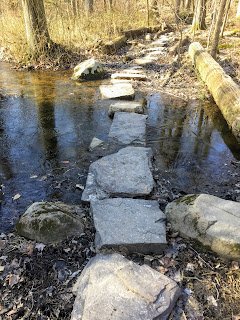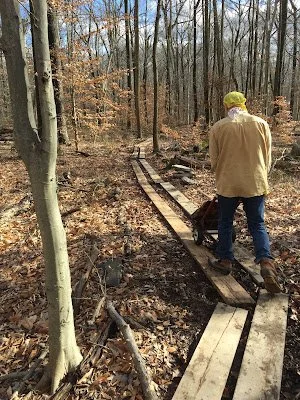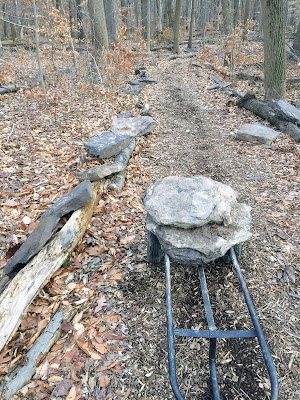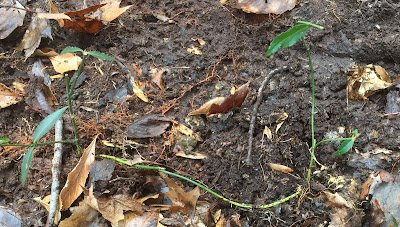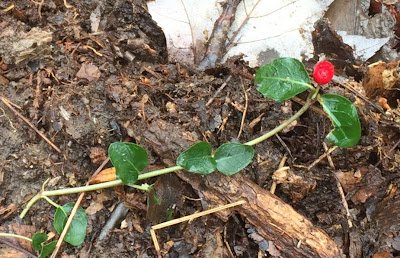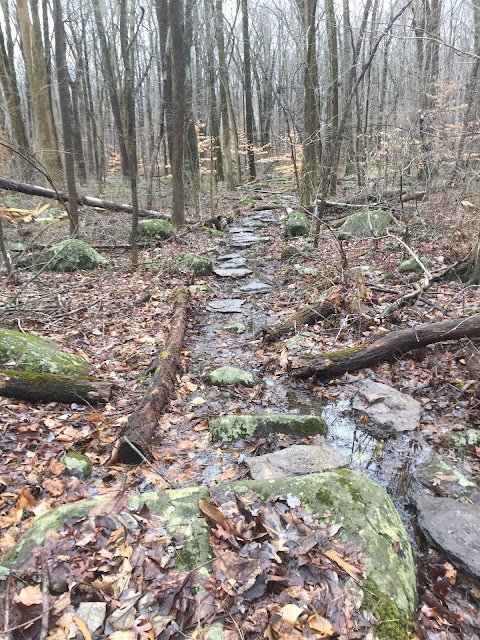Red Trail Now Fully Reopened
A big step has been taken by FOHW to make the red trail--the main trail route in Herrontown Woods--fully usable year-round. In the past, trails in the preserve would dry out in summer as the trees pulled moisture out of the ground, then cold weather would harden the ground in winter. But as rains have increased in New Jersey, and mild winters often fail to freeze the ground, the season when trails are soft and muddy has expanded. Though volunteers have laid hundreds of stepping stones along trails in Herrontown Woods, a 500 foot section in the northwest corner of the preserve has long seemed beyond remedy. A reroute two years ago on what appeared to be drier ground quickly turned to mud, as foot traffic broke down the delicate root structures that had held the highly organic soil together.
This year, however, we set about making a more permanent fix. It began, as most major initiatives do in Herrontown Woods, with Kurt Tazelaar focusing his energy on the problem. First came a reworking of large stepping stones to cross the stream. He then stockpiled 100 large stepping stones along a pathway leading into the preserve from Stone Hill Church, occasionally assisted by family and friends. The stones came from the Windy Top development on Snowden, where periodic excavations for new homes have for years now been our handy go-to for stones that vary from small to massive.
In a project that sometimes felt like building a railroad through the wilderness, Andrew Thornton and I then laid scavenged boards down to form a plankway. The planks allowed us to transport the heavy stones down to the red trail without getting bogged down in the mud.
As with so much of our work, simple machines in the form of a hand truck made the impossible possible.
During a stretch of days when no one else was available, I finished a usable version of the trail. The new route is actually the original route from previous decades, through a swamp forest habitat that hikers don't experience elsewhere in the preserve. Some of the planks used earlier became boardwalks. The crosspieces are posts scavenged when the Princeton Shopping Center took down an old fence several years ago.
One of the interesting plants found along this section of trail is Hearts-a-burstin (Euonymus americanus), a native shrub common in Herrontown Woods but rare elsewhere along the Princeton ridge. Though this native shrub can grow up to ten feet tall, in Herrontown Woods it seldom rises more than a few inches above the leaf litter before being nibbled down by the deer. This aggressive browsing is an example of how deer prefer to consume native plants, while leaving the closely related but nonnative winged Euonymus to reach maturity and spread its seeds.
The native Euonymus has taken to growing horizontally, surviving amidst the leaf litter through the decades in its miniature state. We've featured these shrubs in the sunnier, more protected environs of the botanical art garden, but one possibility is to cage some of these shrubs along the trail and allow them to grow, making the trail over time a Hearts-a-burstin alleyway.
Another native plant found in winter along the trail is partridgeberry. A few of these found in the trail path were transferred to the botanical garden.
It's a relief to have a workable trail through the wettest section of Herrontown Woods. We'll see how it performs through the heavy spring rains, when the preserve plays the role of a giant sponge, absorbing water and slowly releasing it into Harry's Brook. Watching how water levels change with the season, we may find out why, for instance, this root is actually traveling above ground, with curious knobby growths along its length.
Working on trails can be considered an alternative to going to the gym, and at Herrontown Woods there will be no end to opportunities for exercise. Stepping stones and boardwalks are to these trails as research is to science--more are always needed.

